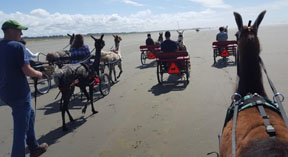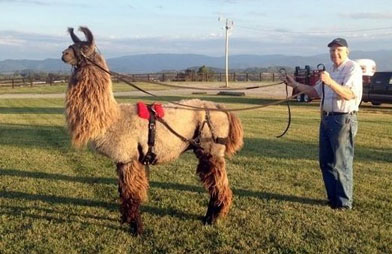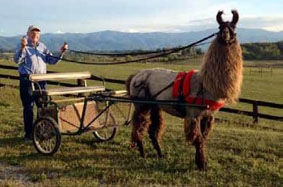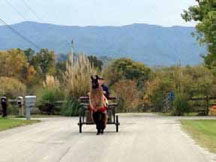Cart Driving with Llamas

He’s Driving Me &?#% !
I Mean… He’s Driving Me!
By Tom Hudgin, Photos by Mary Lou Hassell
“Giddy up.” A few seconds followed with no response.
I said, ”Giddy up.” Again, I sat there in the driver’s seat, hands holding the loose reins in vain while the large hunk of gray matter in front stood there chewing his cud and gazing off towards the Tennessee mountains. The only movement in that hot bod was the chomping jaw full of cud and twitching ears. Great! Maybe this is how they define progress in Tennessee, but it ain’t where I came from. I tried again with a lot more determination.
“HEY, YOU UP THERE! MOVE IT!”
At that point, Tevye put his ears back and wham: he kicked the cart. “What the ----! I spent months learnin’ you how to pull this contraption, and this is what I get?”
At that moment a pickup truck approached us from ahead. The driver, in bib overalls and straw hat, had his left arm hanging down the outside of the door. I assumed the door would have fallen off if he let go. I heard things are different in Tennessee. He slowed to a crawl and stopped.
“Howdy there. How’s your donkey doin’?”
“Sir, he ain’t no donkey. In fact, he’s smarter than your old rusty truck!” I snorted.
The farmer reached around with his left arm and opened his door from the outside.
“What did you say about my truck?!”
“Tom, wake up! You must be having a nightmare. You were mumbling to someone about a donkey,” she said as she shook me.
“Yeah, it was weird, something about… oh, never mind.”
It all started last spring when I was searching for another llama to train to drive a cart. I knew that 80% of a successful llama cart driver is the overall temperament, attitude, demeanor and intelligence of the llama…before you start the training. The training part is fairly straight forward, for some anyway. So the trick is to find the right llama in the beginning. Only a few llamas have the right combination to become a good driving llama. I had already trained two, one of which was a grand champion. But Matador had gone down on his pasterns and was semi-retired.
I thought I found a llama last winter, but when I started to work with him, I discovered he was afraid of cars, dogs, tractors, and people. This was not the characteristics of a good cart llama. Oh sure, over a period of time I probably could have settled him down and removed those fears, but I did not want to spend months just getting him to the point of cart training.
Mary Lou Hassell suggested one of her older, male llamas might have the right temperament. Never having met Tevye, and in desperation, I headed out to the pasture with a halter and lead in my back pocket. He was busy grazing on the lush spring grass and did not pay attention to me initially. I stopped 50 feet away and started to talk to him quietly expecting him to look up and walk away. He continued eating. I moved closer to 10 feet. He still ignored me. Slowly, I walked up, extended my hand and touched his back. He looked up for a couple of seconds and continued eating. I moved my hand up to his neck, then to the top of his head. He continued eating. Finally, I reached in my back pocket, removed the halter and lead, and held the halter up to his face. Tevye lifted his head up to my shoulders, looked at the halter and stood still. I slipped the halter and lead on. He remained still. Then we walked around the pasture for awhile with Tevye directly behind. And the best part was that he was NOT afraid of dogs, cars, trucks, tractors and strangers. He was the right llama.

We began the training with daily, 30 minute, simple walks on a lead to build a mutual bond of trust. After a week, I was ready for phase one of ground driving training. When I placed a driving halter and reins on him, Mary Lou hooked up a normal lead line to his halter. She led Tevye along as he had been trained to do, while I followed behind with loose reins in hand. To start the forward motion, I said quietly, “Tevye, walk on.” Of course, Tevye had no idea what that meant, so Mary Lou tugged on the lead at the same time and off we went.
“Good boy, Tevye”, I said.
When it came time to stop, I ordered, “Tevye, whoa.”
I gently pulled back on the reins while Mary Lou stepped in front of him. Tevye stopped.
“Good boy, Tevye” I repeated.
We continued the “walk on” and “whoa” process 15-30 minutes a day for several weeks. Tevye had to get this part down perfectly before we moved further. In fact, the most important command to learn without hesitation or second thoughts on his part is “WHOA.” Each day we made progress. Each day I could see subtle signs that Tevye just might be enjoying this. Eventually, we reached the point where Tevye would “walk on” and “whoa” without the aid of the reins or Mary Lou tugging or blocking his path. He was consistent. We were ready for phase two after a little over a month of training.
The next part involved teaching Tevye to turn right and left. I added the empty driving harness strapped on his back. Again, Mary Lou would lead Tevye with a line while I followed behind with the reins. Shortly, I said, “Tevye, turn left” and pulled the reins slightly and gently to the left. At the same time Mary Lou turned to the left and towed Tevye with the lead rope. We continued this process for a week turning only left. The idea was to teach him the association of the words “turn left” and a slight left tug on the reins. After a week, he caught on. Then we did the right side. All along we continued to reinforce the “walk on” and “whoa.” In another month of 30 minute sessions, Tevye had it down pat. He now could start, stop, turn left and turn right… without the cart.
Then came the big challenge – the cart itself. This is a huge transition, because suddenly you are physically restricting his movements forward, sideways and backward and you are adding a lot of weight to pull. I have seen some llamas that passed the test in temperament, attitude, etc., and passed the test of training up to this point with flying colors, then freak out when the cart is attached. In fact, I had a female llama that did beautifully up to the point of attaching an empty cart. She panicked and never was able to go further.

At this stage, we moved our training to an oval, fenced horse ring in case Tevye went wild with the cart hook-up. We tied Tevye to the fence and placed the cart harness on his back while whispering sweet nothings in his ear. Mary Lou stood beside Tevye’s head and held onto the lead while I slowly placed the empty cart into position from behind him. Tevye stood perfectly still. We slowly slipped the lower and upper tugs from his harness onto the cart shafts at the same time on both sides so no sideways weight would be felt. Then we let go of the shafts so he could feel the weight. Tevye continued to stand.
“Bravo, Tevye” We gave him a big hug. I took the lead rope, untied it from the fence and slowly led him around the oval with no one in the cart and no reins. In a sense, we were regressing because we were only introducing the weight of the cart and restricted movements and forgetting about the “walk on,” “whoa,” and “left and right turns” for the moment. During the first half of the loop around the ring, Tevye offered some resistance. He tried to move sideways, then stopped, then jumped forward in an attempt to shake off that cart. He was obviously uncomfortable with the contraption hanging on his back. I expected this reaction, however, and we continued around the ring not giving in. We did nothing but just walk. No commands, no side movements as practiced in the past, just walk. By the time we returned to the starting point in the oval ring, Tevye had relaxed and was trotting right along with no argument. We went around a second time. Finally, I gave the lead to Mary Lou, and I walked behind him and the cart with the reins. The cart remained empty. For the next several weeks, we practiced the commands I had taught Tevye from the beginning while walking behind the cart.
Then the day of reckoning arrived. Tevye was going to pull me in the cart… maybe. We returned to the oval horse ring. Tevye stood perfectly still while we hooked him up to cart. Mary Lou, again, held Tevye in front with a lead rope. I climbed in, ever so gently, and commanded, “Tevye, walk on.” Tevye eased forward. After a quarter trek around the ring, I asked Mary Lou to release the lead rope. It was now or never. I held my breath in anticipation of the worst as we smoothly rode a complete loop around the oval without a flaw.

“WE DID IT! WE DID IT! GOOD BOY, TEYVE!” I shouted, stopped, got out of the cart and gave Tevye a hug and a treat of a handful of feed. I gave Mary Lou a hug and thanked her for her help. I sang “We did it! We did it!” all around the ring, three more times. Every week since that moment, we have taken Tevye out for rides. He has improved each time. We now have booked him for two Christmas parades, one in Jonesborough, TN and one in Boykin, SC. As you can see, it takes the right pick initially and a lot of patience, but it pays off in the end. The last step is teaching Tevye to back up with the cart. I have a plan.
Watch out performance people, we’ll see you at the shows.
One final comment, I had a face to face meeting with one of the nearby Tennessee State Parks Superintendents about the possibility of bringing Tevye and other llamas to the park on a one time trial basis. We were granted permission for a one shot test. No horses or other livestock were allowed, except dogs on a leash. I said we could abide by the dog rules. We took Tevye to the park for a test run in the cart. It was a hit, and we have been granted permission to bring llamas to the Davy Crockett State Park anytime without prior notice. The next step will be to visit another state park in Tennessee using the same “trial approach.” Knowing our success in North Carolina State Parks, I anticipate going to the State Parks Division office in Nashville sometime down the road and request the same permission for all of Tennessee State Parks… just like we did in North Carolina. We are on a roll.
This article originally appeared in the Fall 2014 issue of the Southern States Llama Association Llama Journal. Reprinted with permission.
Like this article? Become a RMLA Member today!

